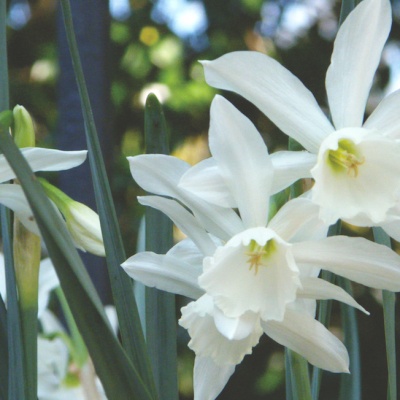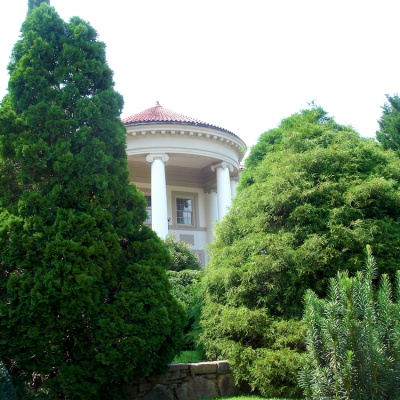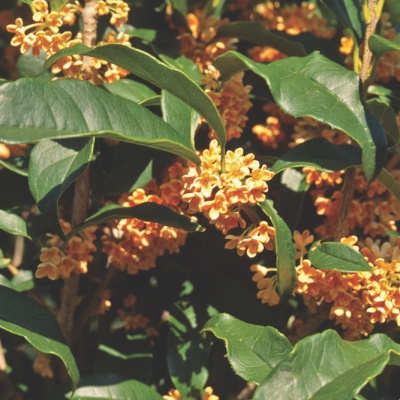The White Album

“[This is] the “Church Garden,” which Mrs. Ferrell furnished with a pipe organ, harp, pulpit, two mourners’ benches and a collection plate all in box[wood]. I plant this garden entirely in white, from the azaleas and wisterias of spring, through the hostas and oleanders of late summer”… Alice Callaway on her white garden, from her chapter in An American Woman’s Garden circa 1984.
I’ll admit being an unsophisticated late-comer to the white flower bandwagon. Excepting flowering dogwood, magnolia and maybe gardenia, white flowering plants just didn’t excite me that much when I first ventured into gardening. Besides, anyone who has ever sold blooming plants knows that vivid, flashy hues are the ones grabbed first. As a matter of fact, I didn’t even want an all-white bridal bouquet, breaking tradition on that point long before it was common. Several unenlightened decades marched by, and then I grew to know Mrs. Callaway and was gently schooled, shall we say.
I began working here in mid-spring of 1994, and her herbaceous peonies were blooming. They were all incredible, but the fully double and fragrant ‘Festiva Maxima’ was the most spectacular to me. Those sparkling white petals with center flecks of crimson took my breath away, so I hurried to add this heirloom peony to my short list of “approved albas.” I already loved roses—they had actually initiated me into the world of horticulture—and the immaculate blooms of ‘White Meidiland’ and ‘Iceberg’ growing in the Church Garden’s White Border contrasted beautifully with the surrounding green foliage. Lamb’s ear and artemisia lent their silver hues and different textures to this composition. I saw that it was quite elegant, and my register grew. Confederate jasmine was blooming nearby on the lattice wall behind the greenhouse, and its sweet scent whispered that it should be written down as well. What else could I do—it had me at near swoon. Deeper in the garden, the lemony fragrance of southern magnolia wafted through the air, which was a good thing considering how rudely messy they are! I might’ve struck them off my listing, but I got the notion that those enormous, glistening blossoms coinciding with tons of leaf fall might just be God’s apology for all of their litter.
My mom and grandmothers had given me an appreciation for daylilies many years earlier, and come that June, two near-white varieties began blooming, also in the white border. They were lovely, and I had never seen any that pale! At one end of the bed was ‘Joan Senior,’ at the other, ‘Gentle Shepherd,’ and in yet another border, she grew ‘Ice Carnival.’ I loved how their bright petals fairly glowed and stood up to the summer’s heat. Rose of Sharon (Hibiscus syriacus) grew as small trees within the Church Garden between a boxwood hedge and an ancient stone wall, and the combination of green foliage and crisp white blossoms looked so fresh and cool. Mrs. Callaway called them altheas just like my grandmother did…I was charmed, so down they went. Pristine balls of smooth hydrangea flowers billowed underneath them, while ecru blooms of oakleaf hydrangea glowed along the southern back wall: both of these native, and far too lovely to be omitted.
That summer was exceedingly wet and dealing with its repercussions seemed to consume us, until a grouping of previously unassuming Callicarpa shrubs rather suddenly demanded attention. The arching branches had been laden with small green berries for weeks, but they hadn’t been very remarkable…until now. Almost overnight, the fruit of these beauty berries had turned—not the more common violet—but pearly white, and Alice was thrilled. She declared them “the prettiest thing in the garden right now” and she wasn’t wrong. I noted that along with blooms and foliage, including showy fruit could add further texture and interest to a design. The rain and heat gradually broke their chokeholds on the weather and fall began sliding in. A huge, old white Camellia sasanqua brightened up an area on top of a wall in the Church Garden early on, but it was several weeks later when the buds on the prettiest one I’d ever seen began to bloom near the Porte-Cochere by the house. It, too, was sizeable (completely filling a corner near a set of steps), clothed in glossy deep green leaves and literally covered in flower buds that had been getting fatter and fatter with each passing day. As they opened up, the green and white combination looked spectacular against the white stucco and limestone of the house. ‘Mine-No-Yuki,’ I thought to myself, you’re the prettiest thing in the garden right now—and I wasn’t wrong. Later I learned that its cultivar name means “White Doves” in the Japanese language. How fitting.
As mentioned in the beginning quote, Alice had converted the Church Garden into a white garden, and her records suggest that she embarked on this metamorphosis rather early in her tenure as the garden’s mistress. During that first winter that I worked here, and also for the subsequent few, I witnessed how unwavering she was on this color scheme. As winter closed in, luminous, milky blossoms of Camellia japonica flanking the back wall and along the west side planted in the Church from the 1940s through the mid-70s began to open. (Yes, I put down white camellias!) Nearly a decade prior to this, in 1985, below zero temperatures had frozen all of the camellias in the garden at least to the ground. Some were killed outright, but others had slowly grown back. Several of the re-grown japonicas were just now beginning to bloom again for the first time since the extreme freeze. If one of them in this particular area dared to sport a blossom that was anything but white, the directive to “dig it out” was issued. Whether Alice was emulating the renowned white garden at Sissinghurst Castle, or had some other inspiration is not known, but a more likely spot could not have presented itself. Mrs. Ferrell’s theme of worship was already present in mature, healthy boxwood topiaries and hedges—the perfect green compliment for a garden of white to express a sense of sacred purity.
In mid-February, I experienced seeing the magnificent specimen of Yulan magnolia burst into bloom for the first time. Planted in 1968, it was nearing 30 years old, and full of precocious buds just itching to open. Thus began my introduction to the ritual “holding of one’s breath” for this tree each year at this time. Native to Asia, and commonly planted at temple sites, the Yulan (Magnolia denudata) wants to bloom early. Perhaps too early, considering how frequently the hundreds of ivory, goblet-shaped blossoms get zapped during a cold night. Perhaps the risk that it takes every year by attempting to open up in the middle of winter is responsible for some of the anticipation and downright joy one feels over experiencing this tree in all its glory. Not only is it on the list, it’s at the top!
By that month’s end, flowers were opening everywhere, and the all-white church garden looked enchanting. Under the Yulan, snowflake bulbs seemed to twinkle, and in another bed were immaculate trumpets of ‘Mt. Hood’ daffodils. Carolina silverbell and weeping cherry soon bloomed along with the lacy, white Chinese wisteria Alice had climbing on cedar trunks planted more than a century earlier. ‘Snow’ Kurume azaleas planted along the west side of the Church lit up against their dark backdrop of cherry laurel trunks. Silvery leaves of lamb’s ear combined beautifully with the blue-green foliage of white bearded iris once again in the white border, while blooming candytuft spilled over its rock edge. The calendar had just about come full circle, and that was just as well: my previously mentioned “short list” had become a full-length album! ~JP

In 1991, Dale Kennington painted this portrait of Alice standing next to the white border she created in the Church Garden. |

A ‘Sombreuil’ climbing rose graces the arbor at the west entrance to the Church Garden. This creamy white rose has a delicious fragrance. |

White Meidiland roses also chosen for this border are disease resistant and perform well in our southern heat. Variegated boxwood and silver foliage incorporate other ways to use “white” in a garden other than blooming flowers. |

Snapdragons, pansies and roses in the white border provide the perfect backdrop for this old stone bench. |

The white flowers of the Yulan Magnolia, set against a crisp blue sky, are a sight to behold in February. |

Sweet smelling Confederate jasmine blooming on the lattice behind the greenhouse in summer. |
View this entire Portico Newsletter:


